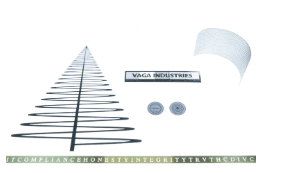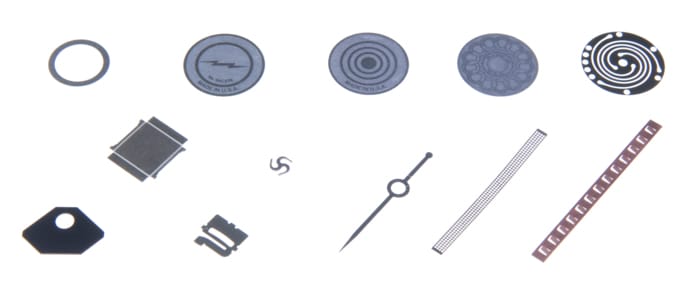
Home > Photo Etching > Photo Etching Requirements
Photo Chemical Machining Requirements
Vaga Industries provides high precision photo chemical machining of thin metal parts for customers in a broad range of markets. The photo etching process is effective with numerous metals and alloys—we stock a large inventory of materials to meet the needs of our customers. We can also work with customer-provided materials, as needed.
Our chemical etching services can be used to fabricate precision parts from nearly any design, no matter how simple or complex. However, there are a number of specific photo chemical machining requirements, characteristics, and tolerance considerations. Many are presented here, but if you have questions about how these chemical etching requirements will affect your parts, please contact Vaga Industries for assistance.
Undercut
As the etchants used in the photo chemical machining process cut through the material, a certain amount of side erosion or undercutting occurs. This is the main factor governing the tolerances that can be held. As the thickness of the material increases, so does the undercut and, in turn, the tolerances that can be held
Hole Size & Metal Thickness
As a general rule, the diameter of a hole created via photo etching cannot be less than the thickness of the material. This relationship varies with the thickness of the metal to a certain extent.
Material Width Between Holes & Metal Thickness
The thickness of the metal being used in the chemical etching process puts limitations on the possible material width between holes. Minimum widths are shown in the table below.
| Thickness | Space Between Holes |
| < 0.005″ | At least metal thickness |
| > 0.005″ | At least 1.25 times metal thickness |
Center-to-Center Dimensions
Center-to-center tolerances are dependent upon the photo tool used in masking the part. These tolerances are proportional to the linear distance involved, as shown below.
| Center-to-Center Dimensions (Inches) | Tolerance |
| 1.0″ or less | ± 0.0002″ |
| 1.0″ to 3.0″ | ± 0.0004″ |
| 3.0″ to 10.0″ | ± 0.0008″ |
Inside Corner Radius & Metal Thickness
Minimum inside corner radius is generally equal to the thickness of the metal. If the metal is 0.005” thick, the inside corner radius will be 0.005”
Outside Corner Radius & Metal Thickness
The normal radius of a sharp outside corner allowed by the photo etching process is 2/3 of the metal’s thickness. Special adjustments can be made if a sharper corner is required.
Edge Bevel & Metal Thickness
A small amount of lateral etching/erosion does occur during photo chemical machining. In most instances, the metal sheet from which parts are fabricated will be sprayed with etching acid from both sides. The resulting edge profile will resemble the drawing below. Bevel “A” is approximately 10 percent of the material’s thickness.
In certain applications, etching from only one side is preferred. In these cases, “B” will be approximately 40 percent of material thickness.
Tolerances on Prototypes & Short Run Production
| Approx. flat size | Thickness (inches) | ||||||
| 0.002 | 0.005 | 0.010 | 0.020 | 0.040 | 0.060 | 0.080 | |
| 2″ x 2″ | ± 0.0005 | ± 0.001 | ± 0.002 | ± 0.004 | ± 0.005 | ± 0.006 | ± 0.007 |
| 8″ x 10″ | ± 0.001 | ± 0.002 | ± 0.003 | ± 0.004 | ± 0.005 | ± 0.006 | ± 0.007 |
| 12″ x 18″ | ± 0.001 | ± 0.002 | ± 0.004 | ± 0.005 | ± 0.005 | ± 0.007 | ± 0.010 |
| 18″ x 24″ | ± 0.002 | ± 0.002 | ± 0.004 | ± 0.005 | ± 0.006 | ± 0.007 | ± 0.015 |
Bend Radii
The table below shows minimum internal bend radii for different types of metals used in the photo chemical machining process. Though the radii shown are generally accepted throughout the industry, prototypes should be made to ensure structural integrity. (SB = sharp bend; T = thickness of material.)
| MINIMUM RADIUS FORMABILITY -90° | |||||
| Material | Alloy | Temper | Across | Grain Direction 45° | Parallel |
| Low Carbon Cold-Rolled Steel | No. 1 | Hard | 2.0 x | 3.0 x T | Flat |
| No. 2 | 1/2 Hard | 1.0 x T | 1.5 x T | 1.5 x T | |
| No. 3 | 1/4 Hard | SB | 0.5 x T | 1.0 X T | |
| No. 4 | Soft | SB | SB | SB | |
| No. 5 | Dead Soft | SB | SB | SB | |
| Stainless Steel | 301/302 | Annealed | SB | SB | SB |
| 1/4 Hard | SB | 0.5 x T | 1.0 x T | ||
| 1/2 Hard | 0.5 x T | 1.0 x T | 1.5 x T | ||
| 3/4 Hard | 1.0 x T | 1.5 x T | 2.0 x T | ||
| Hard | 1.5 x T | 2.0 x T | 3.0 x T | ||
| Beryllium Copper | 25 | Annealed | SB | SB | SB |
| 25 | 1/4 hard | SB | SB | SB | |
| 25 | 1/2 hard | 0.5 x T | 0.7 x T | 1.1 x T | |
| 25 | Hard | 1.0 x T | 2.0 x T | 2.2 x T | |
| Brass | No. 6 | Annealed | SB | SB | SB |
| 3/4 Hard | SB | SB | SB | ||
| Hard | SB | SB | 0.5 x T | ||
| X Hard | SB | 0.5 X T | 2.0 x T | ||
| Spring | SB | 1.0 x T | 3.0 x T | ||
| X Spring | 0.5 x T | 1.5 x T | 3.5 x T | ||
| Phosphor Bronze | Grade A | Annealed | SB | SB | SB |
| 1/2 Hard | SB | SB | SB | ||
| Hard | SB | SB | 1.0 x T | ||
| X Hard | SB | 0.5 x T | 2.5 x T | ||
| Spring | SB | 1.0 x T | 3.0 x T | ||
| X Spring | 0.5 x T | 1.5 x T | 3.5 x T | ||
| Grade C | Annealed | SB | SB | SB | |
| 1/2 Hard | SB | SB | 0.5 x T | ||
| Hard | SB | 0.5 x T | 2.0 x T | ||
| X Hard | SB | 2.0 x T | 4.0 x T | ||
| Spring | SB | 3.5 x T | 5.5 x T | ||
| X Spring | 0.5 x T | 4.0 x T | 7.5 x T | ||
Edge-to-Edge Dimensions
There are a number of parameters involved in determining dimensional tolerances. Among the first should be cost: if a tolerance can be opened up to production parameters and not affect fit, form, or function, it should be used. In some cases, this option is not available, in which case additional quality control measures must be employed to guarantee acceptable parts. This, of course, increases costs.
Tooling Holes
In many instances, photo etching is a practical method of manufacturing formed metal parts. Tooling holes can be located very accurately in relation to the part for secondary forming.
Hand Forming
Bend lines as shown below can be etched into one side of a part. This allows for easy hand forming of sharp bends. However, this does result in the loss of some structural integrity.
Request a quote for your project, or contact Vaga Industries for more information on our photo chemical machining requirements.







